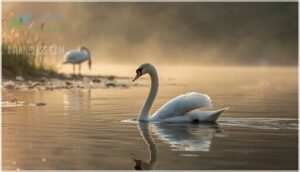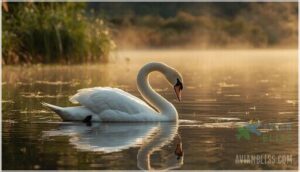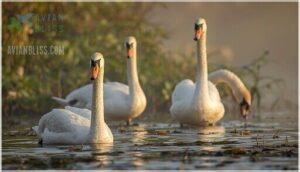This site is supported by our readers. We may earn a commission, at no cost to you, if you purchase through links.

Female swans are smaller yet more strategic, quieter yet more communicative, and they shoulder nearly all incubation duties while guarding their cygnets with startling aggression. Understanding how to identify a pen reveals a complex creature whose physical traits, behaviors, and maternal dedication shape entire wetland ecosystems.
Table Of Contents
- Key Takeaways
- Female Swan: Terminology and Basic Facts
- Physical Characteristics of Female Swans
- Behavioral Traits of Female Swans
- Reproductive Cycle of Female Swans
- Female Swan Species-Specific Characteristics
- Conservation and Human Interaction With Female Swans
- Frequently Asked Questions (FAQs)
- What is a female swan called?
- How do you know if a swan is a male or female?
- What type of bird is a swan?
- What is a baby swan called?
- What is the female version of a swan?
- How do you tell male and female swans apart?
- Why are female swans called pens?
- What is a word for female swan?
- Do female swans sleep on land or water?
- What threats do female swans face in modern society?
- Conclusion
Key Takeaways
- Female swans, called pens, handle 81-99% of incubation duties while males patrol territory, but don’t let that fool you—these mothers defend their nests and cygnets with startling aggression that’ll send intruders twice their size running.
- You can identify a pen by her smaller frame (averaging 9 kg versus males at 12 kg), more compact bill knob, and sleeker neck posture, though plumage stays nearly identical between sexes across most species.
- Female swans shape entire wetland ecosystems by consuming over 40% of their body weight daily in aquatic vegetation, preventing plant overgrowth and creating diverse habitats that support double the bird species compared to non-nested areas.
- Modern threats hit pens hard—habitat loss has eliminated 60% of global wetlands since 1900, lead poisoning kills up to 38% of swans in contaminated zones, and predators claim roughly 50% of cygnets plus 22% of nesting females annually.
Female Swan: Terminology and Basic Facts
If you’ve ever wondered what to call a female swan or how she differs from her male counterpart, you’re about to break free from the mystery. Understanding swan terminology isn’t just academic—it’s your gateway to truly appreciating these splendid birds in the wild.
Let’s explore what makes a pen unique and why recognizing her matters for anyone passionate about waterfowl.
Definition of a Pen (Female Swan)
A female swan is known as a “pen” across all swan species. This term originates from the English word “Penne,” which refers to the way she holds her wings in a penned position. Understanding this terminology is crucial for identifying female swans in the wild, though recognizing a pen involves more than just knowing her name. Here’s what defines these elegant waterfowl:
- Official designation: “Pen” is the standardized term in ornithology and conservation work
- Minimal dimorphism: Female swans look remarkably similar to males, making terminology key for identification
- Universal application: The term applies to all Cygnus genus species, from trumpeters to mutes
- Etymology roots: The “Penne” origin reflects observed female swan behavior and posture
- Documentation importance: Researchers rely on “pen” identification for breeding records and behavioral studies
You’ll find that pens share more similarities than differences with their male counterparts, which is why swan etymology matters when you’re learning to distinguish between the sexes. To learn more about swan species and their social bird behaviors, it’s vital to understand their habitat and social structures.
Comparison to Male Swan (Cob)
When you compare cobs to pens, sexual dimorphism becomes obvious—but you’ve got to know where to look. Adult males usually weigh around 12 kg, while females average 9 kg, creating a clear size comparison in most species. Cobs also sport a much larger knob at the bill base, especially during breeding season. You’ll notice thicker necks and more orange bills on males, while females maintain a slender, more aerodynamic profile.
Despite these differences between male and female swans, plumage differences are minimal—both sexes wear similar white or dark feathers depending on species, making behavioral roles your best identification clue in the field. Understanding the swan breeding season is essential for accurate identification.
Role in Swan Family Structure
Within swan family dynamics, pens anchor the entire social unit through specialized parental care. You’ll see her orchestrating nest construction while the cob patrols nearby—she shapes materials into protective mounds and maintains incubation for roughly 42 days straight. This female leadership extends beyond hatching:
Female swans anchor their families through specialized care—orchestrating nest construction, maintaining 42-day incubations, and leading cygnets beyond hatching
- Guiding cygnets to shallow feeding zones within hours of emergence
- Teaching essential foraging and preening behaviors through direct modeling
- Coordinating family movements and rest cycles for peak cygnet survival
Maternal care defines swan socialization. While both parents contribute, the female swan provides continuous supervision during early development, creating nesting roles that help maintain family cohesion across breeding seasons.
Lifespan of Female Swans
Once you’ve seen how pens organize their families, you might wonder how long these devoted mothers actually live. Female swan lifespan in the wild generally spans 9 to 12 years for most species, though trumpeter swans often reach 15 to 20 years.
Wild survival rates face serious challenges—up to 50% of cygnets don’t survive their first three months. Mortality factors like lead poisoning from fishing tackle, habitat loss, and avian diseases cut many lives short.
In captivity, longevity jumps dramatically: mute swans can hit 30 to 40 years with controlled feeding and protection. Age trends show breeding performance drops after 12 years, and environmental impact matters—protected habitats boost survival rates up to 30 times compared to fragmented landscapes.
Physical Characteristics of Female Swans
When you’re trying to spot a female swan in the wild, knowing what to look for makes all the difference. The pen’s body tells a story through subtle details that set her apart from her male counterpart.
Here’s what you need to watch for to identify her with confidence.
Size and Weight Comparison to Males
Across species, you’ll notice that sexual dimorphism makes males consistently heavier than females. Male mute swans tip the scales at 10.6–11.87 kg while females weigh 8.5–9.67 kg—about 20% lighter. Trumpeter swan males average 11–12.7 kg compared to females at 9.4–10.3 kg. Even smaller tundra swans show this pattern, with males at 6.4 kg versus females at 5.7 kg.
Weight differences and size variations include:
- Male swans average 10–20% heavier than females across all species
- Body mass differences become more pronounced with age and breeding condition
- Male wingspan generally exceeds female wingspan by 10–15 cm
- Gender dimorphism appears most dramatically in mute swans, where males can reach 15–23 kg
- The male-female ratio in body length shows males measuring 5–10% longer overall
Neck Length and Posture
You’ll spot female swans by their graceful neck posture and impressive vertebral count. Female mute swans possess up to 23 cervical vertebrae—the highest among birds—giving them remarkable neck flexibility for aquatic feeding.
Watch how they shift between elegant S-curves while swimming and fully extended postures when foraging. That neck structure lets them dive deep to reach submerged plants, sometimes stretching a full meter below the surface.
During breeding season, you’ll see females holding their necks upright for vigilance, protecting their young. Swan posture reveals everything: the relaxed curve means calm waters ahead, while that stiff, extended stance signals she’s on high alert.
Female swan characteristics vary slightly by species, but neck length remains their defining feature for swan species identification.
Bill Shape and Color Variations
You’ll discover bill anatomy tells a story written in pigment and structure. Female mute swans flash orange bills with smaller black knobs—about 30-40% more compact than males. Tundra swan females sport black beaks dotted with yellow patches, while trumpeter females carry solid black bills with pink-edged lower mandibles. Here’s what separates them:
- Mute swan bills glow orange-gold, deepening through breeding seasons as hormones shift
- Black knobs shrink on females, staying static while males’ swell with testosterone
- Tundra patches vary wildly—90% of North American birds show yellow, only 40% in Eurasia
- Trumpeter edges blush pink in roughly 70% of mature females
- Juvenile bills transform completely, morphing from gray-pink to adult colors within their first year
These beak variations make species identification straightforward once you know the color patterns and bill size differences that define each swan’s signature look.
Plumage Differences Across Species
You won’t believe how dramatically swan plumage patterns shift across species and age groups. Adult female Trumpeter Swans wear snowy-white feather coloration year-round, while juveniles start gray and molt to white during their second summer. Tundra Swan females achieve pure white plumage faster—transforming from silvery gray to white by their first spring.
Black Swan females flip the script entirely, sporting jet-black bodies with white flight feathers. Mute Swan females show two distinct molting cycles: Royal morphs shift from grayish-brown to white over twelve months, while Polish morphs hatch beige-white and lighten quickly, proving species variation creates wildly different identification challenges.
Behavioral Traits of Female Swans
Female swans don’t just glide gracefully across the water—they’re fierce protectors and strategic communicators with distinct personalities. Understanding how pens behave helps you identify them in the wild and appreciate their role in swan society.
Let’s break down the key behavioral traits that set female swans apart from their male counterparts.
Nesting and Territorial Behavior
Regarding protecting their future families, female swans transform into formidable guardians of their chosen territories. You’ll witness nest site selection that shows impressive strategic thinking—pens construct massive nests using emergent wetland vegetation, averaging 5 to 6 feet across and up to 2 feet high. These impressive structures are deliberately placed away from shorelines to minimize predation risks.
Their territorial behavior is nothing short of bold:
- Defend territories averaging 13 acres during breeding season with fierce determination
- Expand protective zones after cygnets hatch to secure larger feeding areas for their young
- Display aggressive defense tactics including chasing, loud calls, and wing displays against any perceived threats
Field studies reveal that nest predation accounts for roughly 90% of nesting failures, which explains why pens are so relentlessly protective. Their nesting strategies balance concealment with visibility—they avoid dense tree cover, preferring open water sites where they can spot danger approaching from any direction.
Vocalizations and Communication
Female swans are far from silent; they possess a diverse vocal repertoire with at least six distinct call types, including snorts, hisses, whistles, and grunts. These pens employ acoustic signals for various purposes, such as alarm, contact, and courtship, each serving a specific function in their communication. Mute swans produce softer vocalizations that carry only 50–100 meters, whereas trumpeter swan females emit higher-pitched calls averaging 300–350 Hz.
Their bird language is rich and nuanced. Rapid alarm notes are used during 80% of predator encounters, while soft “glock-glock” calls help coordinate parenting duties. Interestingly, female swans take the lead in protecting their young, initiating alarm calls in approximately 60% of threat situations.
| Call Type | Frequency Range | Primary Function |
|---|---|---|
| Contact Calls | 300–350 Hz | Maintain pair bonds and coordinate movements |
| Alarm Calls | High-pitched, rapid | Warn of predators and threats |
| Grunts | 420 Hz average | Territorial defense and short-range communication |
| Maternal Response | 400–800 Hz | Direct cygnets during feeding and travel |
Feeding Habits and Preferences
When you watch a pen glide across the water, you’re witnessing a master forager at work. Female swans spend roughly 38% of daylight hours feeding, with their aquatic diet shifting dramatically through the seasons. In late winter, these waterfowl consume about 61% green algae, then pivot to protein-rich vascular plants like pondweed by spring. Their feeding habits and preferences reveal strategic nutrient intake tied to reproduction—pens gain around 2 kg before egg-laying to fuel the energy demands ahead.
Peak foraging times include:
- Late morning through afternoon for thermoregulation
- Pre-laying periods for maximum nutrient storage
- Shallow eutrophic wetlands within 1-meter depth
- Open-water zones during early thaw
This feeding behavior perfectly prepares them for what comes next: the intricate social dynamics within their flocks.
Social Interactions Within Swan Flocks
Within any swan flock, you’ll see a rich social hierarchy at play. Female dominance shapes group coordination—pens paired with larger males claim top ranks and control prime feeding zones through wing-raising threats and persistent pecking. These dominant females lead spring migration movements using synchronized head-bobbing and wing-opening signals that keep family units intact.
Flock dynamics shift when groups exceed 100 individuals, enhancing collective vigilance against predators. Subordinate pens avoid aggressive zones but participate in cooperative breeding clusters of 10–20 swans, where communal courtship strengthens pair bonds and younger females practice essential bonding behaviors for future success.
| Interaction Type | Female Role |
|---|---|
| Dominance Displays | Wing-raising, threat postures, territory defense |
| Migration Leadership | Coordinate departures, signal flock movements |
| Courtship Gatherings | Initiate 40% of synchronization displays |
| Protective Behavior | Maintain family cohesion through vocalizations |
Reproductive Cycle of Female Swans
Female swans follow a fascinating reproductive cycle that shapes their entire year. Understanding how pens attract mates, care for eggs, and raise their young reveals the dedication these birds bring to motherhood.
Let’s explore the key stages of breeding that define a female swan’s life.
Mating Rituals and Pair Bonding
You’ll spot these elegant courtship displays from March through June, when swan pairs perform synchronized head-dipping and neck-arching rituals. Watch closely and you’ll see couples mirror each other’s movements for 10 to 20 minutes, dipping their heads up to 50 times in perfect harmony.
Female swans actually kick off about 60% of these interactions through subtle bill contact or lowered head signals. This synchronized dancing strengthens their monogamous bond remarkably well, with 91% to 95% of pairs staying together across multiple seasons.
Their devotion pays off too. Stable pair bonding boosts offspring survival by 25% and cuts reproductive energy costs by 15%. Swan mating rituals repeat throughout the season, reinforcing their connection even when they’re not breeding.
Egg Laying and Incubation Process
Once that pair bond solidifies, she shifts gears fast. You’ll watch her start laying one egg every other day until she’s built up a clutch of 4 to 7 eggs, though some ambitious females push it to 10 or 11. Egg formation depends heavily on her body weight—heavier females lay earlier and produce larger clutches.
She constructs a massive nest mound using aquatic vegetation and sticks, shaping the central bowl herself. The incubation period stretches from 32 to 45 days, and she manages nearly all of it. She’ll cover her eggs with nest materials when she slips away to feed. Males guard the nesting site but rarely sit.
Hatching rates average 80%, with most cygnets emerging within 24 hours of each other.
Cygnet Rearing and Maternal Care
Female swans embody Maternal Instinct the moment cygnets break shell. You’ll see her supervise feeding sites over 70% of daylight hours, guiding downy youngsters to nutrient-rich shallows while her mate patrols boundaries. Her devotion to Parental Guidance shows in every move:
- Brooding Techniques maintain cygnet temperatures at 36–38°C through repeated warming sessions
- Back-riding transport carries exhausted babies to safety
- Feeding demonstrations where she pulls aquatic plants within reach
- Defensive modeling teaches hissing and wing-spreading by example
This Maternal Care continues for 9–12 months, shaping Cygnet Development through patient instruction in preening, foraging, and flight training.
Annual Breeding Patterns
Each spring, as ice melts and daylight stretches, female swans kick off their breeding season between late April and early June. Breeding Cycles sync with habitat conditions—temperate zones align egg laying with fresh vegetation growth.
Mating Rituals strengthen pair bonds before Nesting Habits begin, with females laying 4–7 eggs over 5–12 days. Egg Incubation spans 32–45 days, and Fledging Rates peak when cygnets hatch into food-rich environments, boosting survival.
Female Swan Species-Specific Characteristics
Not all female swans look exactly alike. Each species shows distinct traits that help you tell them apart in the field.
Let’s break down what makes trumpeter, tundra, mute, and rarer swan species unique when you’re identifying pens.
Trumpeter Swan Female Traits
When you’re tracking trumpeter swan female traits, you’ll notice these powerful birds weigh between 21 and 23 pounds with wingspans reaching up to 10 feet. Female swan characteristics include beginning to breed around age four, then constructing massive nests up to 11 feet wide over two to five weeks.
During the 32 to 37-day incubation period, she’ll rotate her eggs every 20 minutes while her mate patrols their territory. These devoted mothers guide their cygnets for nearly a year, and with swan longevity often exceeding 20 years in the wild, her lifelong pair bond shapes trumpeter behavior across decades.
Tundra Swan Female Distinctions
When you’re identifying tundra swans, you’ll spot female differences that set her apart from other swan species. She weighs between 12 and 15 pounds—lighter than males by roughly 4 pounds—with wing lengths averaging 53.1 cm. Here’s what makes her migration patterns exceptional:
- Spring journeys last 48 days covering 6,471 km with multiple stopovers
- She flies at elevations up to 27,000 feet during peak migration
- Social hierarchy depends on cygnet numbers she brings to wintering grounds
Her feather coloration turns pure white by winter, though juveniles show brownish-gray plumage. That yellow teardrop near her black bill appears in 80% of tundra swans.
Habitat preferences lean toward tundra wetlands and agricultural areas where sago pondweed thrives, making beak variations less pronounced than in female mute swan populations.
Mute Swan Female Peculiarities
When you’re watching a female Mute Swan glide across a pond, you’re seeing one of nature’s most elegant yet misunderstood creatures. Unlike tundra or trumpeter swans, she’s adapted to human-dominated landscapes with distinctive pen behavior that blends grace with grit. Here’s what makes her stand out in swan social hierarchy:
- Weighs 7.6–10.6 kg with a smaller black basal knob than males
- Manages 81–99% of incubation duties solo for 36–38 days
- Consumes over 8 pounds of aquatic vegetation daily through her mute swan diet
Her mating rituals begin around age three, and female migration patterns differ from other species—she’s more sedentary, relying on local habitats. You’ll notice her aggressive displays constitute 7–11% of daytime activity during breeding, proving these female swan characteristics include fierce maternal instincts. Swan gender identification becomes easier when observing her sleek body and subtle bill coloration during peak nesting season.
Rare Swan Species Females
Beyond the common Mute, Trumpeter, and Tundra Swans, rare species females command attention with their exotic beauty and fragile futures. Female Whooper swans migrate at staggering altitudes exceeding 9,000 meters, while black swans in the Southern Hemisphere display jet-black plumage with crimson bills. You’ll find these rare females adapting to shrinking wetlands as habitat preservation becomes critical for their survival.
Conservation efforts have sparked an eleven-fold population increase projected by 2034 for some species, but females still face habitat fragmentation and lead poisoning. Species research reveals that adult female swan characteristics include an 84% annual survival rate, yet breeding success hinges on protected nesting zones and sustained swan migration corridors that connect their seasonal homes.
| Species | Female Weight | Clutch Size | Conservation Priority |
|---|---|---|---|
| Whooper Swan | 8–10 kg | 4–7 eggs | Moderate |
| Black Swan | 4.5–8 kg | 4–7 eggs | Stable |
| Black-necked Swan | 3.5–6 kg | 4–6 eggs | High |
| Coscoroba Swan | 3.8–5.4 kg | 4–7 eggs | Moderate |
Conservation and Human Interaction With Female Swans
Female swans face real challenges in today’s world, but understanding these threats helps you protect the birds you encounter. Conservation efforts focus on safeguarding breeding females and their habitats while managing the delicate balance between wild populations and urban expansion.
Let’s explore how you can recognize these pressures and what role female swans play in keeping wetland ecosystems thriving.
Threats to Female Swan Populations
Survival for female swans has become a high-stakes game. Habitat loss tops the threat list—over 60% of global wetlands have vanished since 1900, stripping away nesting grounds.
Lead poisoning kills up to 38% of tundra swans in contaminated areas, with thousands dying near industrial sites. Climate change disrupts migration timing and shrinks suitable breeding zones by 14% in Arctic regions.
Predators claim roughly 50% of cygnets and 22% of nesting females annually. Human disturbance, pollution effects, disease outbreaks, and power line collisions round out the dangers facing these elegant birds.
Protection Measures for Breeding Females
When threats loom, conservation efforts kick into overdrive to protect breeding females during the breeding season. Habitat preservation means securing wetlands—those 8-to-15-acre zones with shallow water that female swans need for successful nesting. Wetland restoration projects have boosted breeding pairs by 28% in some regions since 2011.
Three game-changing protection measures stand out:
- Nesting platforms float above water level changes and cut chick mortality by 35%.
- Predator control through fencing and wire grids slashes egg losses by up to 50%.
- Protected breeding zones lift adult female swan survival rates to 84% compared to unprotected sites.
You’ll find these tactics working together—island nesting sites, overhead grids to block raccoons, and habitat fencing that reduces human disturbance by 40% during the swan nesting and lifecycle.
Female Swan Behavior in Urban Settings
In urban parks and waterways, female swans have become bold adapters. City nesting happens on floating platforms, grassy islands, and canal edges where human interaction is constant. You’ll see them performing 81–99% of incubation duties even as joggers and dogs pass by.
Urban foraging shifts dramatically—females spend 22% of their time feeding, often approaching humans for bread instead of diving for pondweed. Despite noise and crowds, swan behavior and mating continue successfully.
Female swan behavior traits include fierce nest defense during breeding season, yet they’ve grown surprisingly tolerant of urban life.
Importance in Ecosystem Balance
Female swans aren’t just graceful birds—they’re wetland architects driving ecosystem balance. When females consume over 40% of their body weight daily in aquatic vegetation, they prevent plant overgrowth and maintain open water channels essential for fish spawning. Their grazing creates diverse habitat structures that support double the bird species compared to non-nested wetland areas. Here’s how their role shapes conservation efforts:
- Ecosystem engineering through selective feeding that promotes heterogeneous plant communities
- Nutrient cycling via sediment stirring and nitrogen redistribution
- Biodiversity support by creating variable plant densities for amphibians and invertebrates
- Wetland management by dispersing seeds and controlling dominant species
- Ecological resilience through territorial nesting that stabilizes disturbed habitats
Female swans occupy a critical position linking primary producers to predators, making their conservation essential for swan habitat health.
Frequently Asked Questions (FAQs)
What is a female swan called?
In bird nomenclature, you’ll hear the term pen used to describe a female swan. This species classification comes from old English roots, possibly linked to the Latin word penne, meaning feather or wing. Male swans go by cob, while their offspring are called cygnets.
Whether you’re watching a female mute swan or another swan variety, the term pen applies across species, giving you a simple way to identify her in conversation.
How do you know if a swan is a male or female?
Spotting the difference takes practice, but you’ll get the hang of it. Males sport a larger black knob at their bill’s base—more pronounced during breeding season. They’re also heavier, with thicker necks held straighter.
Females appear more compact and sleek overall.
What type of bird is a swan?
Swans belong to the genus Cygnus in the Anatidae family, which groups them with ducks and geese as waterfowl. These birds live in freshwater lakes, rivers, and wetlands across North America, Europe, and Asia. You’ll find six to seven swan species worldwide, including trumpeter, mute, tundra, and whooper swans. Their striking features—long necks, heavy bodies, and wingspans reaching up to 10 feet—make them unmistakable among water birds.
What is a baby swan called?
You might think baby swans arrive with formal titles and résumés, but they’re simply called cygnets—a term from Old French that means they’re stuck in the awkward phase until age three.
These gray fluffballs often ride their mother’s back for protection while learning waterfowl biology firsthand.
What is the female version of a swan?
You’ll recognize the female swan by her name: she’s called a pen. Female swans generally weigh less than males and have slightly longer necks relative to body size.
While her partner—the cob—guards their territory, she manages most of the incubation duties.
How do you tell male and female swans apart?
You’ll notice sexual dimorphism in mute swans through size variations and beak differences. Males have a larger black knob at the bill base, thicker necks, and weigh around 12 kg versus females at 9 kg.
These male and female differences help with sex identification in swan morphology.
Why are female swans called pens?
You might think the name comes from their behavior, but female swans carry the title “pen” because of Latin roots.
The etymology traces back to “penna,” meaning feather—specifically the flight feathers once harvested as writing quills.
What is a word for female swan?
In ornithology, the term pen refers to a female swan. This waterfowl classification stems from historical bird nomenclature, distinguishing her from the male cob.
You’ll recognize pens across all female swan species by their slightly smaller size and more delicate features.
Do female swans sleep on land or water?
Where you sleep is where you’re safe,” the old saying goes—and female swans choose both water and land for their rest.
During nesting, pens sleep on their nests, protecting eggs through the night while cobs guard nearby.
What threats do female swans face in modern society?
Modern wetlands are disappearing fast. Habitat loss strips away nesting sites, while pollution and lead poisoning kill roughly 70% of affected swans.
Climate change reshapes migration patterns, power line collisions cause sudden mortality, and human disturbance forces females off nests.
Conservation efforts remain critical.
Conclusion
For all the grace she shows gliding across your local pond, the female swan is no delicate ornament. She’s a fiercely territorial mother who’ll chase off dogs twice her size and incubate eggs through storms that would send most creatures fleeing.
Recognizing a pen means spotting her slightly smaller frame, subtler bill knob, and that strategic watchfulness males rarely match. Once you know what sets her apart, you’ll never see swans the same way again—and you’ll understand why wetlands thrive when she does.











